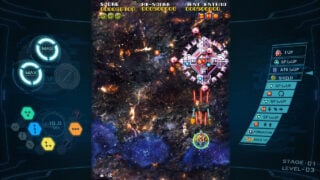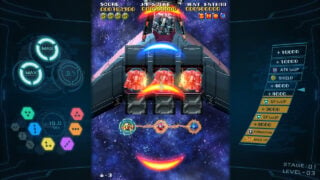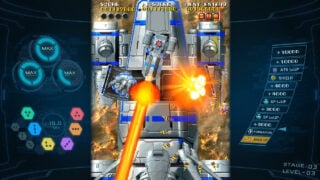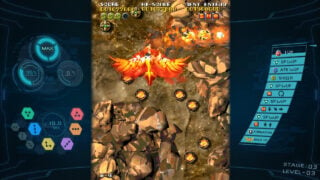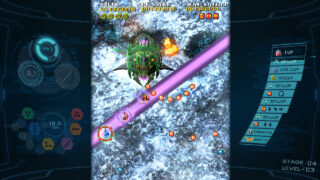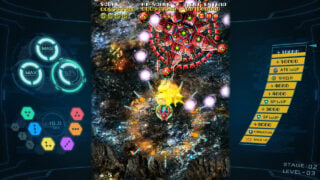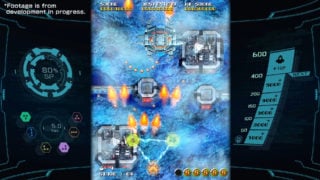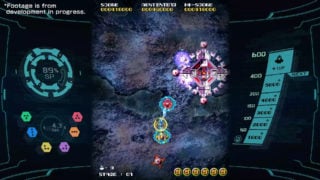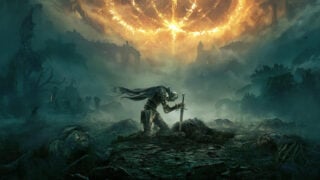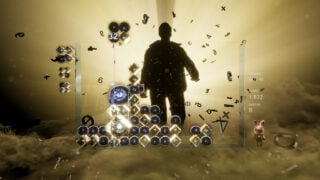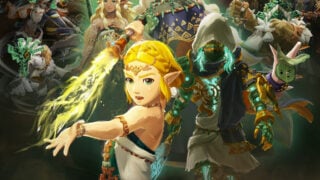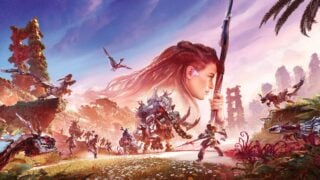Review: Sol Cresta is Hideki Kamiya’s love letter to retro shoot ’em ups
PlatinumGames’ unashamedly authentic retro schmup isn’t cheap, but it certainly made us cheerful
- Creative director
- Hideki Kamiya
- Key Credits
- Takanori Sato (Game director), Yuzo Koshiro (Composer)

It’s still hard to tell whether Sol Cresta was really supposed to be an April Fool’s prank.
First announced on April 1st, 2020, PlatinumGames’ reveal was met with plenty of chuckles from retro fans, who praised the studio on the effort it had gone to to pretend that the long-retired Cresta shoot ‘em up series from the 80s and 90s was making a comeback.
And yet, at the time, many of these retro players (this writer included) followed up these loud chuckles with a quiet “actually, I’d quite like to see that”.
Lo and behold, here we are now nearly two years later, living in a world where Sol Cresta is a very real thing, and a very enjoyable thing at that.
If you’re counting spin-offs, Sol Cresta is the eighth game in the Cresta series, which began in the arcades in 1980 with Moon Cresta and seemingly ended in 1997 with Sega Saturn title Terra Cresta 3D. The game’s intro sequence gives a recap of the previous games’ plots, accompanied by footage of them, but you really don’t need to have any knowledge of the Cresta series to enjoy what’s on offer here.
Indeed, the plot will be so superfluous to most players that there’s no real need to pay attention to it at all, although there is an extra $10 DLC story mode (which wasn’t made available to us at the time of review) for those who do want to explore the lore.
Developed in partnership with Hamster Games – which specialises in re-releasing old arcade and Neo-Geo games on modern systems – Sol Cresta is very much inspired by the ‘90s era of vertical scrolling shoot ‘em ups. The game consists of seven stages littered with enemies and, as is the nature of the genre, gives players one obvious task: destroy anything that moves, and most things that don’t.
The central mechanic the Cresta series has always been known for is the ability to attach things to your ship. In the past, this has usually involved bolting on other ship parts and weaponry to increase firepower. Sol Cresta takes this one stage further by essentially putting the player in control of three different allied ships. The game starts off with one ship, and before long players can collect power-ups that summon the other two allies.
Flying over them bolts them onto the ship, resulting in a big three-ship beauty flying around. The twist here, though, is that each ship has its own different weapon and players can choose which weapon to use by changing which ship is sitting at the front.
Tapping the B button makes time slow down, giving the player time to move their ships around by drawing a line led by the front ship. After moving the ships around, pressing the B button again rejoins the trio, with the ship nearest the top of the screen now sitting at the front.
Each ship’s unique weapon is useful in different scenarios. The red ship fires traditional shoot ‘em up style lasers, which do decent damage to most enemies and can also quickly destroy the red shields that some of them are hiding behind.
Meanwhile, the yellow ship fires small yellow drills, which can easily break rocks that can be hazards in later stages, while the blue ship fires homing missiles which aren’t particularly strong but are great for continuing an attack while focusing on avoiding tricky waves of bullets.
“The central mechanic the Cresta series has always been known for is the ability to attach things to your ship… Sol Cresta takes this one stage further by essentially putting the player in control of three different allied ships.”
Rather than picking a favourite ship and sticking with it, players are encouraged to swap the ships regularly. This is partly done by making various enemies weak against certain ships’ weapons: these are sometimes colour-coded Ikaruga-style but not always.
Regular switching also helps with the power-up crates and bonus rings which regularly appear and are either red, blue or yellow. Players need to be the same colour to be able to destroy the crate or fly through the ring, and get the power-ups or points they hold.
The multi-ship gimmick is used for special formation attacks, which can be collected as power-ups and are stored at the bottom corner of the screen for easy reference. These involve holding the B button down and drawing out a specific shape – similar to the way special attacks are created in The Wonderful 101 – then letting go to lock the three ships in a special formation.
Drawing a triangle, for example, makes the ships sit in a triangle formation and fire a large scatter-shot attack for a limited time: this isn’t massively powerful but is great for bosses with multiple weak points. On the other end of the scale, arranging the ships in an L-shape lets them fire an extremely powerful beam in a diagonal direction, which works best for bosses with a single weak point.

These special techniques can take a little practice to pull off, especially under pressure, but that just adds to the risk/reward factor. If they’re properly executed they can turn the tide of a difficult section, but if the player messes up drawing out the shape because they’re distracted by incoming shots, they leave themselves open to attack.
The game’s general presentation is strong. Its retro-style visuals are pleasantly fitting of the era they’re trying to represent, and fans of the original games will enjoy the more detailed representations of certain enemies.
The soundtrack is also a high point, which is no surprise given that it was created by the legendary Yuzo Koshiro (of Streets of Rage fame) and offers a fantastic array of retro-style themes that perfectly fit the game’s shoot ‘em up stylings.
As for how much of a challenge it puts up, most players should be able to find something that fits their tastes, with the default difficulty in line with most shoot ‘em ups of the era. A reasonably skilful player should be able to get through the first few stages without too many issues, but may struggle with the back half of the game until they practice enough to learn every enemy’s positioning and weaknesses.
“The soundtrack is also a high point, which is no surprise given that it was created by the legendary Yuzo Koshiro (of Streets of Rage fame) and offers a fantastic array of retro-style themes that perfectly fit the game’s shoot ‘em up stylings.”
Players can start a new game from any stage they’ve already reached, and can adjust the difficulty level as they see fit, so if Stage 4 is proving particularly difficult it’s possible to get Game Over then restart Stage 4 at an easier difficulty to progress further.
Purists may baulk at this, but given that the aim of shoot ‘em ups is generally to build high scores, and given that anyone who drops the difficulty will face fewer enemies, experts won’t have to worry about newcomers beating their scores by taking the easy route. No harm, no foul.
There’s also an achievement system that rewards players with new features for ticking off certain accomplishments. These start off fairly easy (completing every stage in Very Easy difficulty, pulling off all the Formation Attacks in a single stage) and get harder: challenging players to beat every boss without taking a hit, for example.
Completing these achievements unlocks various new modes, the first being a Sound Test. This wouldn’t be particularly exciting were it not for the fact that Koshiro’s soundtrack is a retro banger.

Without spoiling anything in detail, ticking off further achievements unlocks modes that will appeal more to experts, and these modes come with online leaderboards. Once it’s possible to upload scores and see where they fit in a global high score table, this is where Sol Cresta potentially really comes into its own for shoot ‘em up aficionados.
Speaking of aficionados, there’s also the option to switch the display 90° to provide players with a ‘TATE’ mode set-up, making it look more like a classic arcade shoot ‘em up. The game is much better suited to this aspect ratio, and while only a few players will be lucky enough to have vertical monitors, Switch owners will be able to simply rotate the handheld 90 degrees and play that way.
One disappointment, however, is that it’s not possible to also rotate the movement controls 90°, like some other games do, meaning the only way to play vertically on the Switch is to hold a controller separately. This makes it impossible for Switch Lite owners to play the game vertically, and even for those with removable Joy-Cons it would still be arguably more comfortable to play with the left Joy-Con attached to the ‘bottom’ of the screen.
“The game is much better suited to the vertical aspect ratio, and while only a few players will be lucky enough to have vertical monitors, Switch owners will be able to simply rotate the handheld 90 degrees and play that way.”
While we’re on disappointments, we should also note that the performance is slightly clunky, at least in the Switch version (we’ve yet to test the PS4 or PC versions, which we’d hope would be smoother). Scrolling can sometimes stutter, especially when playing in docked mode, and there are occasions where the game will actually freeze for a second when bosses appear.
The scrolling stutters certainly aren’t enough to ruin the game, because when you’re getting stuck into the action you almost certainly won’t have time to notice. It can be a little distracting during quieter sections, though, and these imperfections can ruin the immersion a little.
Another potential sticking point here for some players will be the price. Modern video game trends have determined that $40 may be considered too much for a retro shoot ‘em up for some players (especially with the optional $10 story DLC on top of that).
For anyone who’s still just dabbling with the genre, there are a slew of genuine retro shoot ‘em ups – many of which have been published on the Switch by Hamster itself – which serve as perfectly fine entry points at a fraction of the cost. For those who already adore the genre, however – the sort of people who call them ‘schmups’ – Sol Cresta is a fantastic shooter that won’t leave you disappointed.
Sol Cresta is a fantastic shoot ‘em up that should keep fans of the genre entertained for a long time. Die-hard shooter fans won’t be disappointed.
- The ship-swapping mechanic is fantastic once it all clicks
- Wide variety of difficulty options
- Looks and sounds great, and TATE mode is a treat
- No option to rotate movement controls.
- The Switch version is prone to stuttering
